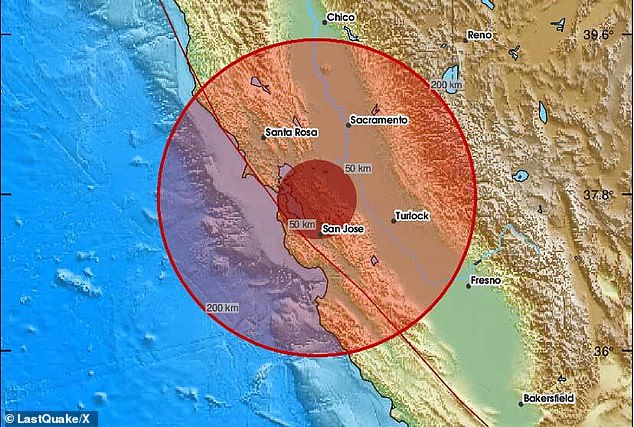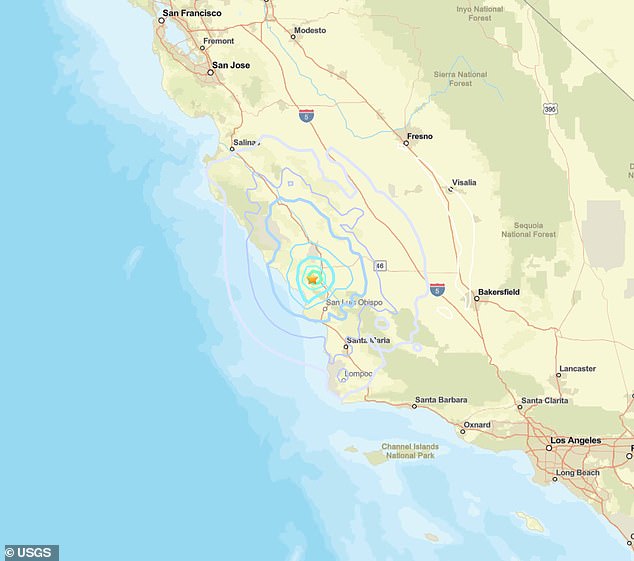A sudden earthquake swarm has been rocking the Central Coast of California, hours after a significant tremor sent shockwaves throughout the region.
More than a dozen earthquakes have been reported by the US Geological Survey (USGS) since Tuesday afternoon, all centered in a one-mile area near Templeton and San Luis Obispo.
The latest aftershock hit at 6.44am ET Wednesday morning, registering as a minor magnitude 2.0 quake. Just three hours earlier, a more powerful 3.3 magnitude earthquake shook the coastal region.
The swarm began after a 4.1 earthquake erupted just four miles away from the town of Templeton at 12:54pm ET on Tuesday.
The sudden quake was reported up and down the coastline, from Salinas in the north to Lompoc in the south, both over 60 miles away.
However, the 4.1 quake caused more chaos closer to its epicenter near Templeton, with local winemaker Brad Ely telling KSBY ‘it felt like I had been hit by a truck.’
No injuries or damaged property was reported after the earthquake, but the region is now dealing with continued aftershocks of Tuesday’s seismic outbreak.
As of Wednesday morning, 13 quakes have been recorded in the area by USGS, ranging from 1.1 to 4.1 in magnitude.

An earthquake swarm has continued to rock California’s Central Coast since Tuesday’s major quake near the town of Templeton

A magnitude 4.1 earthquake hit California on Tuesday, sending shockwaves over 60 miles in all directions
Templeton is located near the 800-mile-long San Andreas Fault, which is the major plate boundary responsible for much of California’s seismic activity.
Geologists have feared that it is only a matter of time before an even larger earthquake, called ‘The Big One,’ will erupt along the fault line and devastate the West Coast.
While that future earthquake has been projected to be over magnitude 7 or 8, even Tuesday’s magnitude 4.1 was powerful enough to cause locals to panic.
Templeton resident Paula Scallan said: ‘I was in my bedroom, and it felt literally like my roof was going to cave in. It just shook.’
Quakes between 2.5 and 5.4 in magnitude are often felt but only cause minor damage.
Ely noted that the larger quakes toppled bottles and glassware at his winery in Paso Robles, right near the epicenter of the swarm, but no structural damage to any buildings has been reported.
Wine distillery owner Joe Barton added: ‘Everything was on the floor, not dissimilar than it was back in 2003. Not quite as many bottles like in 2003. This whole thing was on the floor.’
Seismometers have also detected the weaker aftershocks overnight, but Californians likely did not feel anything under magnitude 2.

Shockwaves from Tuesday’s initial earthquake were reported up and down the coastline, reaching Salinas in the north and Lompoc in the south

Officials detected the first earthquake on Tuesday just outside Templeton on the Central Coast, setting off tsunami detectors as far away as Canada
Swarms that can last for hours or days have been a common side effect following significant earthquakes in California.
In July, dozens of earthquakes rocked Southern California, with some of the seismic events reaching 4.3 in magnitude.
Those earthquakes broke out just a few dozen miles from several active fault lines running through California, including the San Andreas.
The San Andreas runs from Southern California, through the Central Coast and Bay Area, and all the way to the northern part of the state.
USGS has warned that the San Andreas Fault could generate ‘the region’s largest magnitude earthquakes,’ potentially reaching up to 8.2 in strength.
Experts are ‘fairly confident that there could be a pretty large earthquake at some point in the next 30 years,’ Angie Lux, project scientist for Earthquake Early Warning at the Berkeley Seismology Lab, previously told the Daily Mail.
Simulations of the devastation showed the next Big One would cause roughly 1,800 deaths, 50,000 injuries, and $200 billion in property damage, according to the Great California Shakeout.
While most seismic experts have been focused on points in Southern California and the Bay Area as likely eruption points along the San Andreas, one recent study warned that the Central Coast could still be the surprise epicenter of the Big One.
Scientists noted that the Sagaing Fault in Myanmar was very similar to the San Andreas, spanning more than 700 miles and suffering it last major rupture in 1839.
When scientists tried to simulate the next series of major earthquakes along this fault for the next 1,400 years, they came to one conclusion: the fault line never ruptured the same way twice, making disaster preparations impossible.
The study, published in the Proceedings of the National Academy of Sciences , also found that these mega earthquakes strike every 141 years and average around 7.5 in magnitude.
The last time the San Andreas suffered a mega earthquake was in 1857, 168 years ago.

